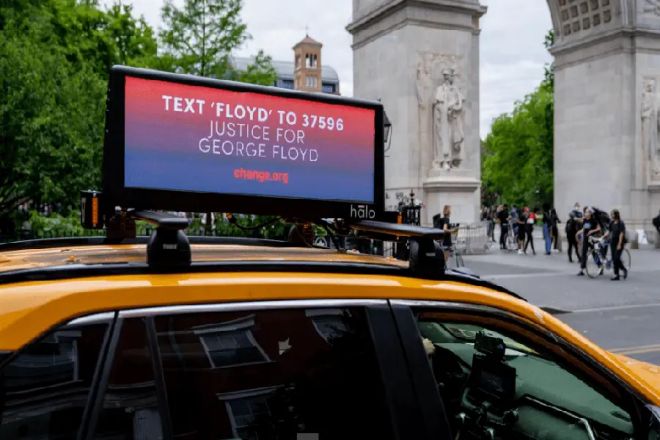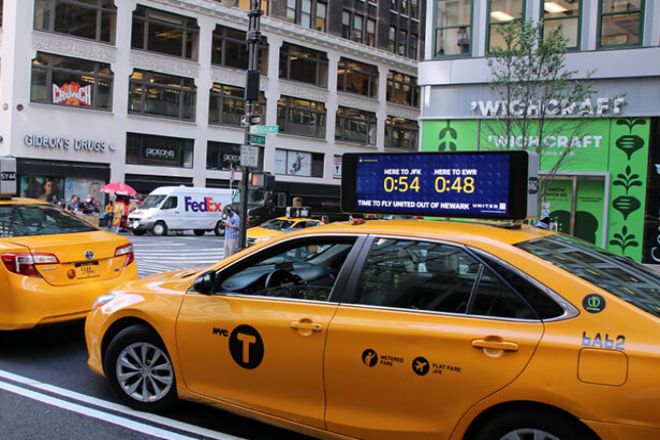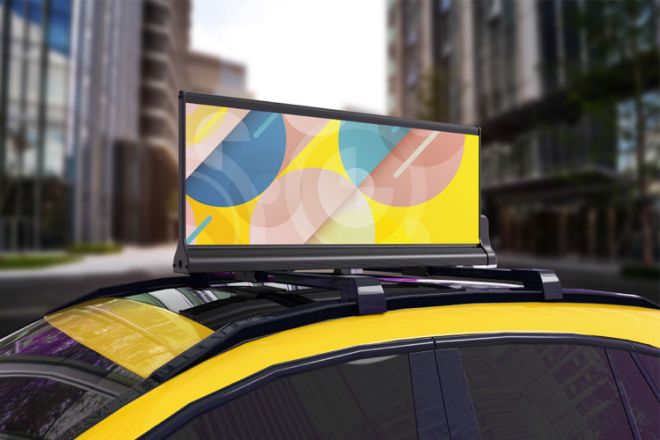Introduction

As one of the most widely used devices for advertising and information dissemination in the taxi industry, LED taxi screens are gradually changing the visual landscape of the city with their high brightness, long life, and excellent display effects.
This guide aims to provide readers with comprehensive information about LED taxi screens, from basic knowledge to selection, installation, maintenance, and market application, to help you better understand and utilize this modern advertising medium.
1. Basic knowledge of LED taxi screen
LED taxi screen, also known as LED display screen, is a display screen made using light-emitting diode (LED) technology. The following are some basic knowledge about LED taxi screens:
- Composition:
LED taxi screens are usually composed of display unit boards (modules), control systems, power supplies, and other parts.
The display unit board is composed of multiple LED lamp beads and is responsible for displaying images and text; the control system is responsible for controlling the on and off of the LED lamp beads to achieve effects such as image display and text scrolling.
- Type:
LED taxi screens can be divided into single-primary, dual-primary, and three-primary color displays according to display color; they can be divided into graphic and text screens, synchronization screens, and market price displays according to display performance; they can be divided into indoor screens according to the use environment. , outdoor screen, and semi-outdoor screen.
- Advantages:
LED taxi screens have the advantages of high brightness, long-distance visual effects, clear images, bright colors, good stability, low power consumption, high light efficiency, and long life, so they are widely used in advertising, information release, and traffic instructions. And other fields.
- Resolution:
The resolution of an LED taxi screen refers to the number of pixels on the screen, usually expressed in terms of the number of horizontal pixels and the number of vertical pixels. The higher the resolution, the clearer the displayed image.
- Viewing angle:
The viewing angle of the LED taxi screen refers to the maximum angle at which the screen is observed. Beyond this angle, the observer will not be able to see the content on the screen clearly. Therefore, when choosing an LED taxi screen, you need to choose an appropriate viewing angle based on the actual use environment and viewing distance.
- Brightness:
The brightness of the LED taxi screen refers to the intensity of the screen’s light, usually expressed in candelas per square meter (cd/m²). The higher the brightness, the better the visibility of the screen under strong light, but too high a brightness may cause visual fatigue and discomfort.
2. Performance parameters and selection suggestions for LED taxi screens

When purchasing LED taxi screens, the key performance parameters that need to be paid attention to include brightness and viewing angle, resolution and pixel density, color performance and restoration, refresh rate, grayscale, etc.
Brightness and viewing angle determine the visual effect of LED taxi screens in outdoor environments. Generally speaking, the higher the brightness, the larger the viewing angle, and the better the display effect.
Resolution and pixel density affect the clarity and detail expression of the image. The higher the resolution, the greater the pixel density and the clearer the image.
Color performance and restoration determine the color display effect of LED taxi screens. Generally speaking, the brighter the color and the higher the restoration, the better the display effect.
When selecting a model, factors such as vehicle model suitability, operating environment, needs, budget, and return on investment also need to be considered. Different types of taxis have different requirements for the size and installation method of LED taxi screens, so the selection needs to be based on the actual vehicle type.
In addition, the operating environment and needs are also important factors in selection. For example, the waterproof, dustproof, earthquake resistance, and other properties of the LED taxi screen, as well as the playback requirements of advertising content, need to be considered.
Finally, budget and investment return are also factors that need to be considered. The appropriate LED taxi screen product needs to be selected based on the actual budget and expected return on investment.
3. Installation and maintenance of LED taxi screens
1). Installation part:
- Control system working conditions:
Before installing the LED taxi screen, it is necessary to ensure that the working conditions of the control system meet the requirements, including hardware configuration (such as CPU, memory, hard disk, etc.), operating system, related software, and environmental requirements (such as temperature, humidity, power supply, etc.).
- Control system installation guide:
Install according to the control system installation guide, including the installation of the synchronous display control card and the wiring of the control system board. During the installation process, you need to pay attention to turning off the power of the computer and display screen to avoid live operation.
2). Maintenance part:
- Daily protection:
In the process of daily protection of LED taxi screens, you need to pay attention to keeping the power supply stable, avoiding use in harsh natural environments (such as strong lightning weather), and preventing water, iron powder, and other easily conductive metals from entering the screen. Things.
At the same time, dust and dirt on the screen surface should be cleaned regularly to avoid affecting heat dissipation and display effects.
- Regular inspection and maintenance:
technicians will conduct regular on-site inspections and maintenance every month to ensure the normal operation of the LED taxi screen.
During the maintenance process, attention should be paid to checking whether the connection cable of the display screen is loose or damaged and the normal operation of the control system.
- Troubleshooting:
When the LED taxi screen fails, maintenance personnel should be contacted in time for processing.
During the maintenance service period, common faults should be resolved within 8 hours, and serious accidents should not exceed 24 hours. Repairs requiring replacement of modules or other accessories should also not exceed 24 hours.
4. Market application of LED taxi screen

LED taxi screens have a wide range of applications in the market, including the taxi advertising market, smart cities and transportation informatization, and in-vehicle entertainment and information systems.
In the taxi advertising market, LED taxi screens have become one of the preferred media for advertisers due to their high brightness, long life, and excellent display effects.
In terms of smart cities and transportation informatization, LED taxi screens can be used as part of the traffic information release platform to provide real-time traffic information and public service information.
In terms of vehicle entertainment and information systems, LED taxi screens can be used as part of the vehicle multimedia system to provide functions such as entertainment information and navigation services.
5. Development trend of LED display screen
In the future, the development trend of LED taxi screens will be towards technological innovation and upgrading, intelligence and networking, green environmental protection, and sustainable development.
Technological innovation and upgrading will promote the continuous improvement of LED taxi screens in terms of display effects, stability, safety, and other aspects.
Intelligence and networking will enable LED taxi screens to be integrated with technologies such as the Internet and the Internet of Things to provide richer functions and better user experience.
Green environmental protection and sustainable development will become important development directions for the LED taxi screen industry, promoting the industry to develop in a more environmentally friendly, energy-saving, and sustainable direction.
Conclusion
The above is the ultimate guide to LED taxi screens. Is there anything you want to know about LED taxi screens?
We hope that this information can help readers better understand and utilize LED taxi screens and contribute to the development of the taxi industry and advertising industry.
If you are interested in LED taxi screens, please get in touch with us!
